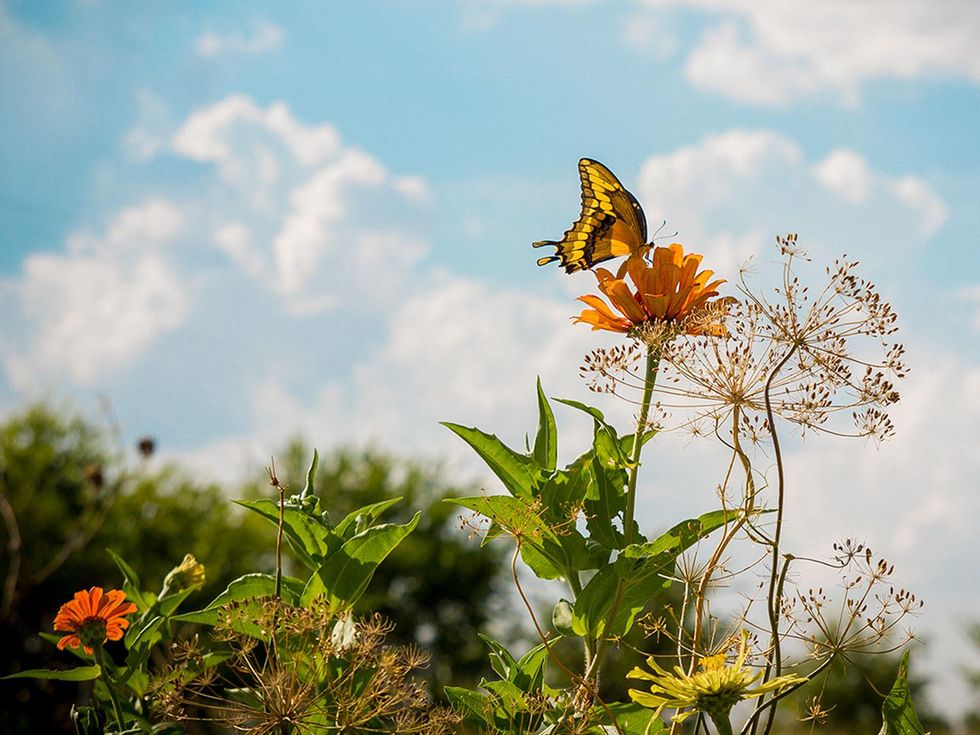The Farmer Diaries
Texas farmer closes out summer garden with an ode to the butterfly
In the final few weeks of summer, little remains growing on the farm. Melons peaked at the end of July. Tomatoes have stopped setting fruit; eggplants and peppers look haggard. Everything has died or gone dormant in the relentless heat and severe drought.
Yet among this wasteland are droves of beautiful, lively swallowtail butterflies, more than I've ever seen in the past. Their black-and-yellow wings catch my eye as I prepare the garden for cool season crops or water a few tomato plants I try to keep alive until the autumn rain arrives.
There's no missing them, nearby or off in the distance; their wingspan is almost as large as the palm of my hand. They're skittish on first encounter, quickly fluttering away over dried stalks of corn out on the periphery. After a while, they circle back to the garden, attracted to the thriving zinnias my wife planted last spring. These flowers have continued to grow and bloom, attracting several species of butterflies, native bees and a group of hummingbirds, giving them an oasis in the parched countryside.
The beds of zinnias and dill provide everything a swallowtail butterfly needs throughout its life cycle: nectar for the adults and a nursery with nourishment for the caterpillars.
In the four decades I've lived on this land, I see the evidence of a changing climate in the way the land isn't budding out with the abundance of fall wildflowers it had in the past. The zinnias, cosmos, scented tobacco and other flowers I tend along with my vegetable crops are more than just ornamentals; they're sustenance for insects and hummingbirds.
Keen on meeting the needs of the swallowtail butterflies, my wife also planted dill. Dill serves as a good home or "host plant" for swallowtail butterflies. Butterflies rely on host plants to survive. The best known example of a host plant is milkweed and monarch butterflies; no other plant will nourish them or fill them with the toxic substances that deter birds from eating them.
For swallowtails, host plants can be dill, parsley or fennel, all in the same plant family with carrots and related to native Texas prairie parsley that grows wild. The beds of zinnias and dill provide everything a swallowtail butterfly needs throughout its life cycle: nectar for the adults and a nursery with nourishment for the caterpillars.
After waiting from April to June with no sign of swallowtail butterflies, I finally spotted the first arrivals in mid-summer. First, swallowtail butterflies arrived at the beds of zinnias and fluttered from plant to plant for about a week. Soon afterward, small caterpillars with black, yellow and white stripes appeared on the stalks of dill.
Every day the worms grew longer and fatter until they they were the size of short marker pen. Then, over the course of several more days, they moved on to form a chrysalis, to transform into their butterfly stage. By August, the population of adult butterflies doubled, maybe tripled. This newer generation is now mating and laying little green solitary eggs, about the size of a cake sprinkle, on the leaves and stalks of my dill.
These swallowtails are efficient pollinators, but there's more to it than that. If not for the chores of watering and weeding, I'd while away my afternoons sitting for hours and watching them visit each flower. They fix my attention as they fly overhead and flitter around erratically, eventually taking roost somewhere just before sunset. They simply deserve to be beheld, and it makes me happy to be their admirer.




